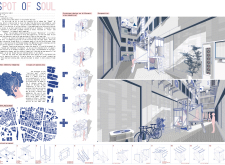5 key facts about this project
The Tokyo Meditation Cabin is located in the busy urban setting of Tokyo, designed to create a peaceful space for reflection amidst the city's rapid pace. It aims to respond to the demands of modern life, providing an area where individuals can slow down and reconnect with themselves. The overall concept focuses on fostering mindfulness through specific spatial designs that address the challenges of urban living.
Modular Design
The prototype is based on a core unit measuring one square meter, allowing for flexible expansion into two, three, or more units based on site characteristics. This modular approach helps the structure adapt to various urban contexts, turning underused spaces into locations for meditation and contemplation. It emphasizes a design that changes with its environment, making connections to the surrounding area.
Integration of Natural Elements
The design also carefully incorporates elements from nature and cultural practices. Natural light, temperature shifts, and the sound of temple bells contribute to creating a calming environment that encourages meditation. The relationship with these natural features enhances the user experience, reinforcing the goal of providing a serene space in the midst of a bustling city.
Material Considerations
In terms of materials, the Tokyo Meditation Cabin primarily uses timber and fabric. The warmth of timber helps to create a welcoming atmosphere, while fabric elements add comfort and intimacy. These materials are chosen for their ability to connect users to their environment, supporting the overarching intention of the design.
User Interaction
The project places significant importance on community engagement. By utilizing transitional spaces, the cabin aims to encourage interactions among individuals while still allowing for personal moments of solitude. This combination of shared experiences and quiet reflection enriches the overall use of the cabin, promoting mindfulness in an otherwise hectic environment.
The design includes openings that let natural light enter, casting changing patterns throughout the day. These variations invite users to experience time differently, fostering a state of calm and contemplation within the urban landscape. The thoughtful design details guide users into a more reflective mindset, creating a welcome sanctuary that contrasts with the surrounding activity.



















































